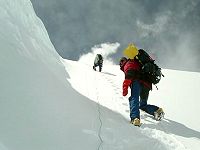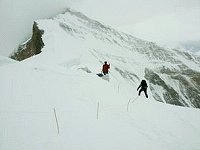| |
 |
Saint
Petersburg: JUBELEE
EXPEDITION "EVEREST 2003" | 19
April, 2003 Tom Masterson: St.
Petersburg English language Everest report continued Tuesday, 8 April 2003: Tingri
to Everest base camp. Today we get an earlier start: breakfast is at 5:45
Nepali time or 8 a.m. Chinese time (Nepali time seems to have the sun nearly overhead
at noon while Chinese time is set in Beijing and decreed to be the same for the
entire of the country, and, yes, Tibet is in China). Tingri has spectacular views
of Everest and Cho Oyu. We left Tingri shortly after 9 (Chinese, all future times
will be referenced to Chinese times) passing ~ 20 jogging Chinese soldiers, in
formation if not quite in step. The short road to Qomolanga (Chinese name for
Everest, with various
transliterations) heads south just a couple kilometers
east of Tingri, but we take the long road which is 40 km further east. This Friendship
Highway is paved for ~ 2 km either side of Tingri, while all the rest (that we
have seen) is not much more than single-lane dirt. Our Chinese driver likes to
drive as fast as he can make the new Toyota Landcruiser go as fast as he can and
occasionally loses control on corners and soft spots. Just
before Shegar we take the 100 km Everest Base Camp Road to the south. The road
has been worked on extensively and receives heavy traffic. Particularly impressive
are the dozens of switchbacks leading from the
Friendship Highway junction
at 4000 m to a high pass at about 5100 m. The top of the pass reveals a stunning
view of Makalu, Everest, and Cho Oyu. Fabulous views (also of Shisha Pangma) continue
as we wind our way back down, especially when the driver can be convinced to slow
down a bit so that we are not overcome with dust from vehicles in front of us.
With less than10 km to go, we stop at the Rongbuk (also various spellings) Monastery.
This austere setting has an incredible view of the north face of Everest. We are
allowed into the stupa while the monks are chanting and these few moments of quiet
meditation are wonderful indeed. Then we continue on to the end of the road on
the tailings of the Rongbuk glacier to Everest Base Camp. Base
camp! We are reunited with warm clothes and equipment. The elevation is ~
5200 m. Tents have already been set up and we work on making solar panels operational
and even getting an electric light into each tent. Our Nepali cook, Xasta, fixes
us our first non-Chinese meal since leaving Kathmandu. A short walk up the glacial
moraine barely gives us an impression of the immensity of the place. Everest towers
to the south soaring above 7500+ m peaks in between. When the sun sets to the
west of the rim of the glacial valley, the temperature drops impressively, probably
more than -15 C.
Wednesday, 9 April 2003:
Everest Base Camp The St.
Petersburg group has brought a lot of technological equipment, including a satellite
telephone, an electrical generator, solar panels, and two laptops computers (one
for e-mail, one for digital photos). But the equipment brought in by other groups
makes ours pale by comparison. The Chinese group (~140 people including 7 climbers)
is planning a live TV transmission from the summit and will lay a fibre optics
cable from base camp (BC) to advanced base camp (ABC), a distance of at least
15 km. The Global Extremes/Mount Everest/4Runners of Adventure/Outdoor Life Network
group has a cast of hundreds and only 4 people attempting to climb (either none
or at most one of whom has high altitude experience). There
are some beautiful red thrush-like birds on the moraine. The wind blows quite
strongly up and down the moraine as well, and can be very cold. A hike up the
east side of the glacial valley revealed some Tibetan inscriptions on the top
of the ridge. The scree was very loose. After lunch we packed everything for the
yaks cartage to ABC.
Thursday, 10 April, 2003:
BC to 1st intermediate
Camp. The yak herders arrived about 1:30 p.m., and finally got loaded about 4:30
p.m. with the solar panels being hand carried instead of yak-backed. The yaks
carry impressive loads of at least 60 kg, and they move smoothly and not slowly.
Snow doesn't bother them and they will seek out such patches for a drink along
the way. We
went up the main Rongbuk glacier for ~ 3 km before turning southeast up the East
Rongbuk. The total time and distance today is short, less than 3 hours even for
the yaks, with an elevation gain of about 300 m. We will take
3 days to gain
the 1400 m to ABC. The views of the yaks traveling up the Rongbuk with Everest
in the background are very memorable. It feels nice to be moving and heading uphill
this evening at about 5400 m. The Tibetan yak herders (both male and female +
1 dog) are friendly and it would be nice to be able to communicate better with
them. We fall asleep to the beautiful sounds of yak bells.
Friday, 11 April,
2003:
1st to 2nd Intermediate camp. We move further up the E. Rongbuk glacier
to about 5800 m. The scenery is gorgeous. Huge (30 m high) teeth of white ice
start to appear out of the glacial moraine. It was delightful to hear the sounds
of a yak man guiding his yaks down from above 6000 m while singing in a deep Tibetan
baritone which reverberated off the steep walls of the glacial valley. In
the last hours before dusk, this intermediate camp became flooded with yaks and
climbers. There are probably more than 200 yaks here - I was able to count 70
directly in front of our campsite.
 | Saturday,
12 April, 2003:
Intermediate camp to ABC. After a cold night, we left 2
tents at the intermediate camp (which is about half-way to ABC). It is a long
but quite pretty walk to ABC beside the Rongbuk icefall. We went up to almost
the end of the moraine, and then returned to nearly the beginning of ABC as all
our gear got unloaded from the yaks there. The Chinese are very territorial about
who goes where and threatened to stone anyone who tries to place a camp anywhere
near a place that they have marked with a small ribbon. We spent over 2 hours
trying to flatten some tent sites with dirt from the edge of the moraine. It was
nice to listen to the yak herders singing while going uphill at 6000 m while still
going as fast as most of us can walk. |
Sunday,
13 April, 2003:
ABC to bottom of North Col. We walk up to and make a depot
at the bottom of the North Col. The flat area for the last km below the Col is
all ice, some of it blue glacial ice, the rest hard and crunchy snow-melt ice.
About 200 m of fixed rope is put in to start the route up the Col. | |
 | Monday,
14 April, 2003:
Fixing ropes to the top of the North Col. We return to
the base of the North Col, and fix ropes up to the top of the Col at ~7000m. Two
of the St. Petersburg climbers did most of the work while the rest of us carried
ropes, pickets, and ice screws. Steepest pitch is about 60 degrees for 30 m or
so. We also moved the tent/gear depot to the top of the Col, but returned to ABC
to sleep. |
Tuesday,
15 April, 2003:
Back to BC. We walk the long trek (~15 km?) back to base
camp.
Wed + Thurs, 16 & 17 April, 2003:
Base Camp.
Friday,
18 April 2003:
2 climbers head back up to ABC in 2 stages.
Saturday,
19 April 2003:
Most the rest of team heads back up to ABC in 1 long day.
| | |





